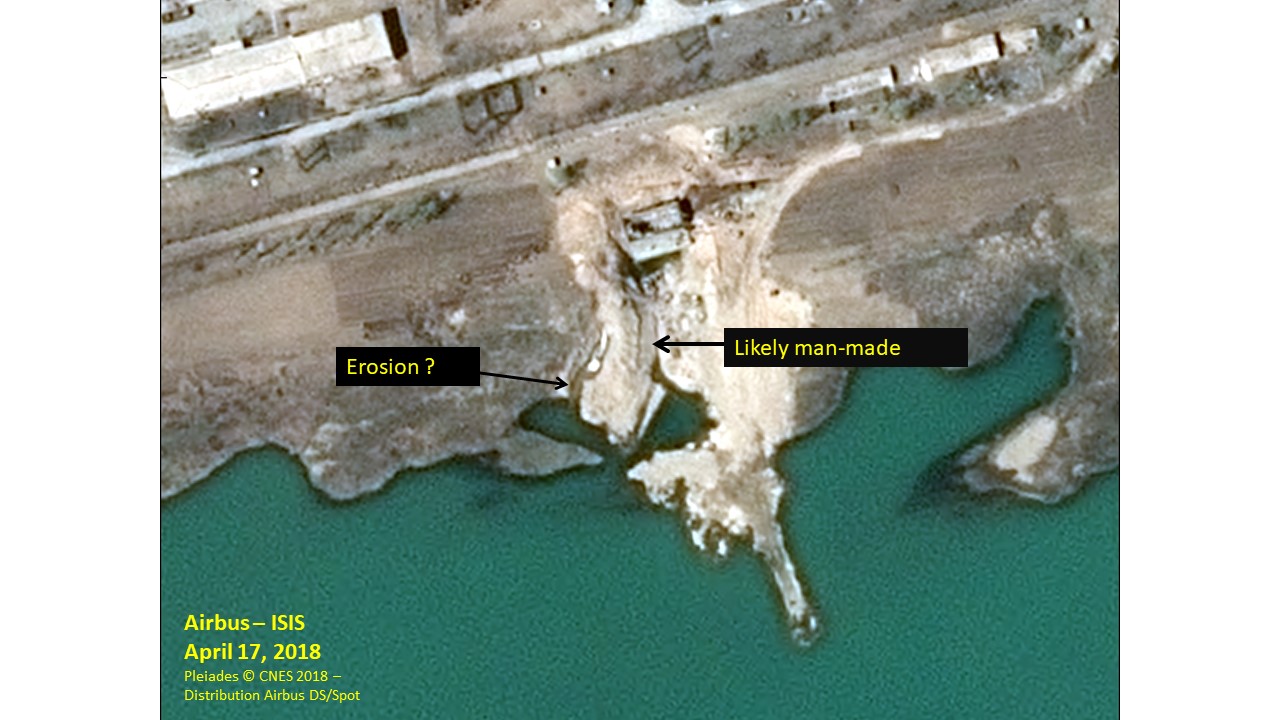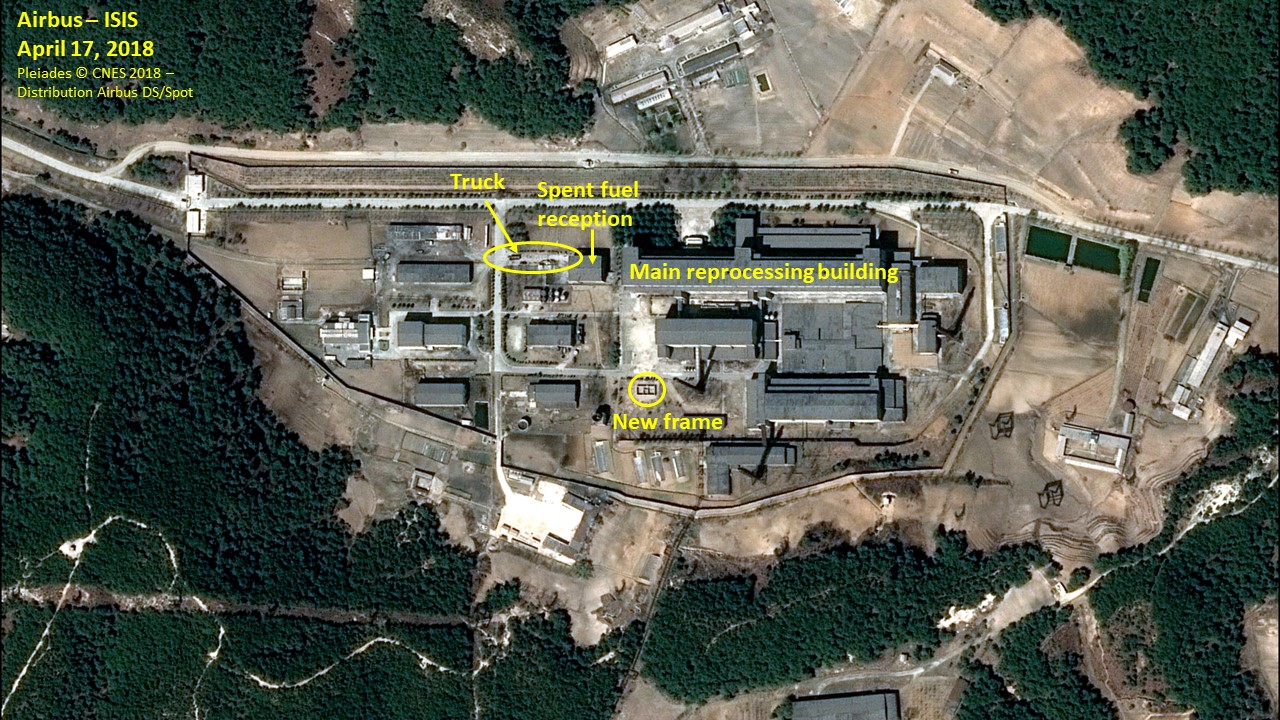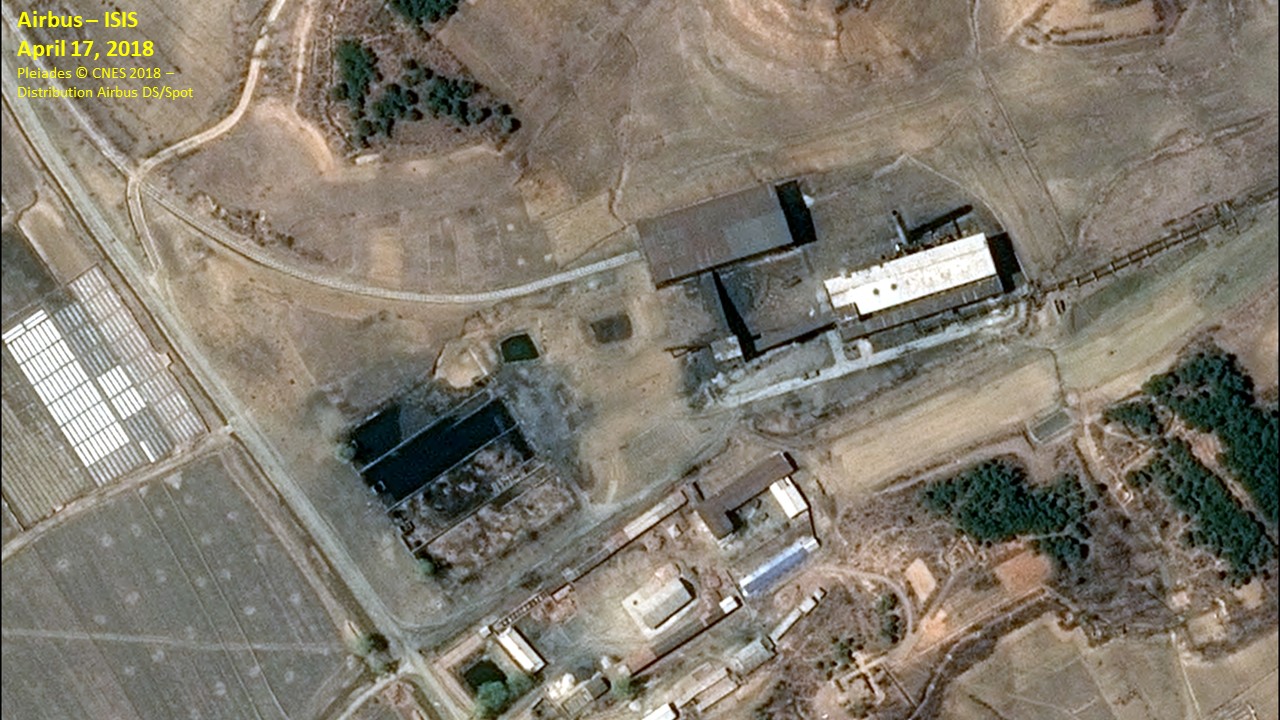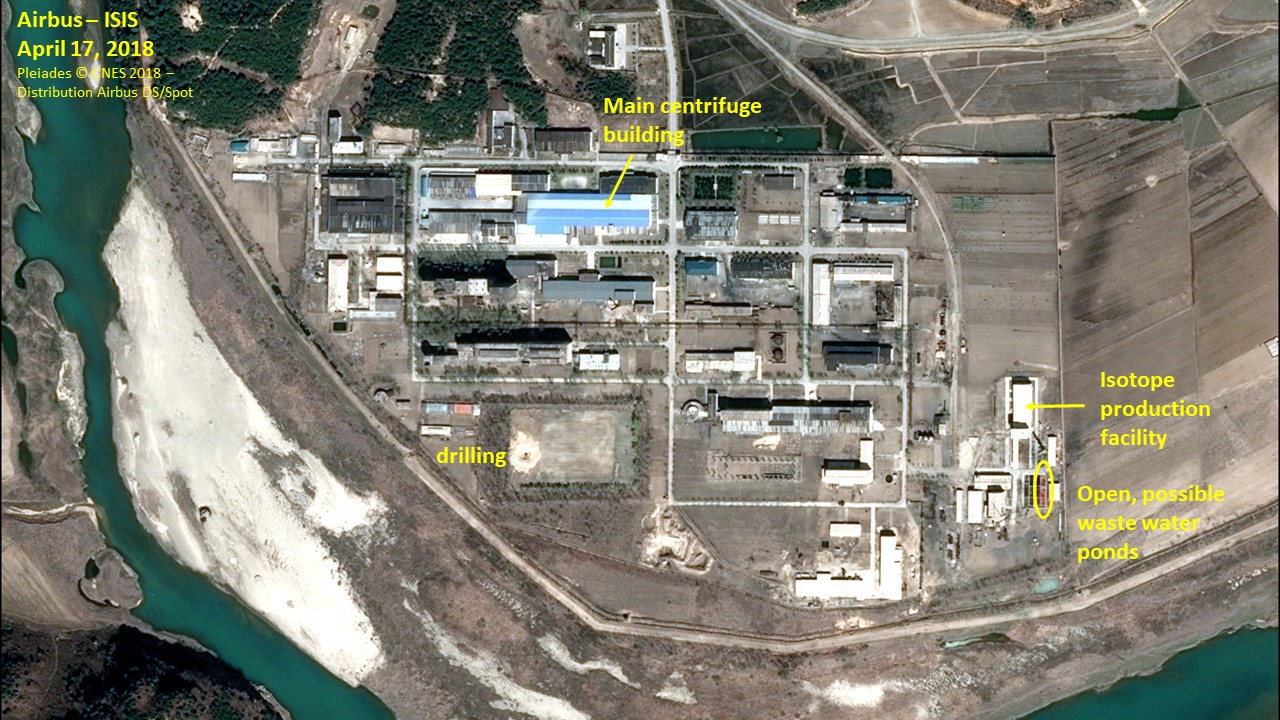Reports
Continued Monitoring of the Yongbyon Nuclear Site
by David Albright and Sarah Burkhard
April 18, 2018
Based on April 17, 2018 Airbus commercial imagery, on-going construction near the secondary cooling system of the 5 megawatt-electric (MWe) reactor raises questions whether the reactor has shut down or is using an unknown, alternative route for the outflowing water. For example, it could be discharging water into the river through a newly installed pipe that is no longer visible in commercial satellite imagery. Monitoring of activities at the Radiochemical Laboratory remains critical. Following Central Intelligence Agency (CIA) director Michael Pompeo’s reported visit to North Korea a little over two weeks ago,1 it would be highly provocative if discharged irradiated fuel from the 5 MWe reactor were reprocessed at the Radiochemical Laboratory, leading to the separation of plutonium for nuclear weapons. The adjacent Experimental Light Water Reactor (ELWR), also capable of producing plutonium. The Institute reported earlier this month that the reactor was starting operation or was undergoing pre-operational testing.2 Whether it is operational now could not be determined from the April 17, 2018 commercial imagery.
5 MWe reactor: operational status and secondary cooling system
Based on assessing April 17, 2018 Airbus imagery, the water discharge portion of the 5 MWe reactor’s secondary cooling system seems to be undergoing continued construction (see figure 1). A building-like structure has been constructed in the sand. No obvious signs of current water outflow are visible, but light water outflow may have caused some minor erosion in the estimated area of the end of the discharge pipe. This was already visible at the end of March 2018 (see figures 2 and 3). The building structure is rectangular and nondescript, but it could possibly become a pump house similar to the pump house for the ELWR further downstream.
It is unclear if the reactor is operating from the visible evidence. The current lack of visible water outflow may indicate that the 5 MWe reactor is operating at low power, is shut down, or is using an alternative route to discharge water from its secondary cooling system into the river. For example, it could be operating at high power and discharging water into the river through a newly installed pipe that is no longer visible in commercial satellite imagery.
In recent months, there has been no indication of reprocessing visible at the Radiochemical Laboratory. Only small visible changes can be noted in the most recent Airbus image from April 17, 2018. A truck is seen nearby the spent fuel reception building, and a previously-seen unidentified object remains nearby. However, the coal-fired thermal plant that produces steam for the reprocessing plant shows no significant signs of activity (see figures 4 and 5).
Status of the Experimental Light Water Reactor
As reported in February 2018, the ELWR appeared to be nearing operation or was undergoing pre-operational testing, after a several-year delay.3 Some reports indicated recent testing of the secondary cooling system.4 Since then, further preliminary testing activity was reported. In mid-March, IHS Jane’s reported potential emissions from the tall stack of the reactor, which could indicate testing of internal reactor components.5
The Institute reported in early April that the ELWR showed possible visible signs of operation or pre-operational testing.6 It cannot be discerned from the April 17, 2018 Airbus image whether the reactor is operational (see figure 1). The image does show that the cleared area in the river by the pump house appears filled with water. Moreover, it appears shallower than its surrounding water, indicated by the discoloration. It is unclear whether the pump house is for water intake or discharge. Additionally, new construction material is visible outside the reactor.
Fuel Fabrication Complex
More than likely, the gas centrifuge plant continues to operate. The operational status of the Isotope Production Facility is unclear. However, visible are what appear to be newly opened, possible waste water ponds, some of which were covered in a March 30, 2018 image (see figure 6). The content of the uncovered ponds appears reddish in color.
Figure 1. The construction by the secondary cooling discharge pipe of the 5 MWe reactor is on-going. A building-like structure, possibly a pump house, is visible in recent Airbus imagery.
Figure 2. A March 30, 2018 Airbus image shows the beginning of the construction by the discharge pipe.
Figure 3. A small channel to the river is visible, possibly from erosion, which may have been caused by light water outflow. Another visible connection to the river is likely man-made.
Figure 4. The Radiochemical Laboratory shows no major visible signs of activity.
Figure 5. The coal-fired steam generation plant shows no visible signs of operation. Operation would indicate the operation of the nearby Radiochemical Laboratory.
Figure 6. No major signs of activity at the Fuel Fabrication Complex are visible. A small drilling project, and newly opened possible waste water ponds by the Isotope Production Facility, are visible.
1. Shane Harris, Carol D. Leonnig, Greg Jaffe and David Nakamura, “CIA Director Pompeo met with North Korean leader Kim Jong Un over Easter weekend,” The Washington Post, April 18, 2018, https://www.washingtonpost.com/politics/us-china-trade-dispute-looms-over-trump-summit-with-japans-abe/2018/04/17/2c94cb02-424f-11e8-bba2-0976a82b05a2_story.html?utm_term=.8c1a4c06461d ↩
2. Albright and Burkhard, “North Korea Continues Expanding its Reactor Capability for Making Plutonium for Nuclear Weapons,” Institute for Science and International Security, April 5, 2018, http://isis-online.org/isis-reports/detail/north-korea-continues-expanding-its-reactor-capability-for-making-plutonium ↩
3. Albright, Burkhard, and Allison Lach, “On-Going Monitoring of Activities at the Yongbyon Nuclear Site,” Institute for Science and International Security, February 13, 2018, http://isis-online.org/isis-reports/detail/on-going-monitoring-of-activities-at-the-yongbyon-nuclear-site/10#images ↩
4. Allison Puccioni and Elliot Serbin, “North Korean ELWR makes progress towards Operations,” Jane’s Intelligence Review, January 3, 2018, http://www.janes.com/images/assets/853/76853/North_Korean_ELWR_makes_progress_towards_operations.pdf ↩
5. “Jane’s Discovers Likely Operational Testing at North Korean Nuclear Reactor,” IHS Markit, March 16, 2018, https://ihsmarkit.com/research-analysis/Janes-Discovers-Likely-Operational-Testing-at-North-Korean-Nuclear-Reactor.html ↩
6. Albright and Burkhard, “North Korea Continues Expanding its Reactor Capability for Making Plutonium for Nuclear Weapons.” ↩







 twitter
twitter